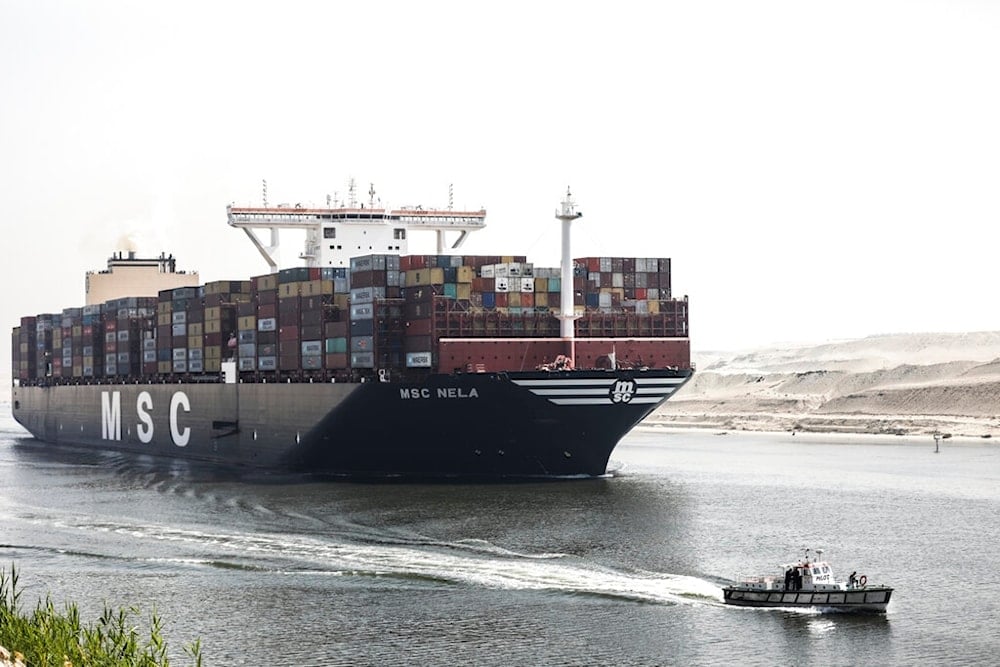Yemeni resistance actions unleashes 173% surge in container spot rates
The disruptions in the Red Sea have led to a slowdown in Suez Canal traffic, as Israeli-linked ships opt for alternative routes to avoid potential conflicts with the Yemeni resistance.
-

A container ship passes through Suez Canal, Egypt, Tuesday, April 6, 2021. (AP)
A recent Bloomberg report reveals a staggering 173% increase in the spot price for container shipping, driven by disruptions caused by the Yemeni resistance in the Red Sea. Freightos.com data indicates that the spot rate for shipping a 40-foot container from Asia to northern Europe surpassed $4,000 in mid-December, prompting concerns across the industry.
Freightos reported on Wednesday that shipping costs from Asia to the Mediterranean soared to $5,175, with carriers hinting at prices exceeding $6,000 for this route starting in mid-January. Simultaneously, rates from Asia to North America's East Coast experienced a 55% surge, reaching $3,900 for a 40-foot container.
Read more: Yemeni Armed Forces strike Israeli-bound ship in Red Sea
Judah Levine, Head of Research at Freightos, highlights that services from Asia to northern Europe and the Mediterranean now exceed double their January 2019 levels. Despite this surge, the rates remain below pandemic peaks.
The disruptions in the Red Sea have led to a slowdown in Suez Canal traffic, as Israeli-linked ships opt for alternative routes to avoid potential conflicts with the Yemeni resistance. Shipping lines respond to stretched capacity by implementing price hikes and surcharges for extended delivery times.
Compounding the challenges are increased tensions following a terrorist attack in Iran, claiming over 100 lives. These factors, combined with heightened demand in preparation for China's Lunar New Year holiday, may escalate the risk of congestion, warns Levine.
"This is no longer taking place during the holiday lull either — demand may be increasing as shippers start to pull forward volumes to make up for longer transit times and in preparation for China’s Lunar New Year holiday in early February," Levine said in a blog post. "Together, this could increase the risk of congestion."
Read more: UK, US to turn Red Sea into warzone, launch attack on Yemen: The Times
In the 10 days leading up to January 2, the International Monetary Fund's PortWatch platform reported a 28% decrease in Suez transits, diverting 3.1% of global commerce away from the Red Sea. Emphasizing the Red Sea's systemic importance in handling over 19,000 vessel transits annually, the IMF noted reduced traffic since December 16.
As freight costs surge, cargo owners face concerns of prolonged elevated spot rates, potentially reducing negotiating leverage during long-term contract discussions between March and May. Beyond the container sector, oil tanker markets witness substantial gains, particularly for vessels transporting refined fuels, reaching an impressive $26,000 per day from $8,000 in early December, according to a report by shipbroker Braemar. "Any route involving the Red Sea is red hot," state Braemar analysts, underlining the far-reaching implications of the shipping upheaval.
Read more: US trying to convince shippers to resume sailing via Red Sea: Reports
Since the start of the genocide in Gaza, the Yemeni resistance has been actively undertaking the task of blocking the Red Sea route for Israeli-linked vessels. The Ansar Allah movement stated they would not cease their operations unless the war on Gaza came to a complete halt.
Recently, US Secretary of Defense Lloyd Austin declared the establishment of a multinational operation named Operation Prosperity Guardian aimed at safeguarding the Red Sea in response to the escalating attacks by the Yemenis on cargo vessels. He disclosed that the UK, Bahrain, Canada, France, Italy, the Netherlands, and Norway would participate in the mission. In response, the Yemeni resistance vowed to target any ships aligning with the US-led maritime coalition.

 4 Min Read
4 Min Read








